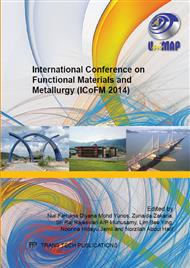[1]
G.C. Bond, D.T. Thompson, Catalysis by gold, Catalysis Reviews-Science Engineering 41 (1999), p.319.
Google Scholar
[2]
M. Haruta, T. Kobayashi, H. Sano, N. Yamada, Novel Gold Catalysts for the Oxidation of Carbon Monoxide at a Temperature Far Below 0°C, Chemistry Letters 16 (1987), pp.405-408.
DOI: 10.1246/cl.1987.405
Google Scholar
[3]
M. Haruta, Gold as a Novel Catalyst in the 21st Century: Preparation, Working Mechanism and Applications, in: Gold Bulletin, Japan, (2004), pp.27-36.
DOI: 10.1007/bf03215514
Google Scholar
[4]
Barksdale, Jelks, The Encyclopedia of the Chemical Elements, in: Clifford A. Hampel (Eds. ), Reinhold Book Corporation, New York, (1968), pp.732-738.
Google Scholar
[5]
M. Valden, X. Lai, D.W. Goodman, Onset of Catalytic Activity of Gold Clusters on Titania with the Appearance of Nonmetallic Properties, Science 281 (1998), pp.1647-1650.
DOI: 10.1126/science.281.5383.1647
Google Scholar
[6]
P. Marage, I.P. Parkin, Aerosol Assisted Chemical Vapor Deposition to Nanocomposite Thin Films, Journal of American Society 128 (2006), pp.1587-1597.
DOI: 10.1021/ja055563v
Google Scholar
[7]
F. Moreau, G.C. Bond, Preparation and Reactivation of Au-TiO2 Catalysts, Catalysis Today 122, (2007), p.260.
DOI: 10.1016/j.cattod.2007.01.017
Google Scholar
[8]
H. Yazid, R. Adnan, M.A. Farrukh, Gold Nanoparticles Supported on Titania for the Reduction of P-Nitrophenol, Indian Journal of Chemistry 52A, (2013), pp.184-191.
Google Scholar
[9]
M. Abdelmoula, E. Panaitescu, M. Phan, David Yin, C. Richter, L.H. Lewis, L. Menon, Controlled Attachment of Gold Nanoparticles on Ordered Titania Nanotube Arrays, Journal of Materials Chemistry 19, (2009), pp.4483-4487.
DOI: 10.1039/b903197a
Google Scholar
[10]
S. Rani, S.C. Roy, M. Paulose, O.K. Varghese, G.K. Mor, S. Kim, S. Toriya, T.J. La Tempa, C.A. Grimes, Synthesis and Applications of Electrochemically Self-Assembled Titania Nanotube Arrays, Journal of Physical Chemistry B 12, (2010).
DOI: 10.1039/b924125f
Google Scholar
[11]
A. Haring, A. Morris, M. Hu, Controlling Morphological Parameters of Anodized Titania Nanotubes for Optimized Solar Energy Applications, Journal of Materials 5, (2012), p.1890-(1909).
DOI: 10.3390/ma5101890
Google Scholar
[12]
Y. Li, Q. Ma, J. Han, L. Ji, J. Wang, J. Chen, Y. Wang, Controllable Preparation, Growth Mechanism and the Properties Research of TiO2 Nanotube Arrays, Journal of Applied Surface Science 297, (2014), pp.103-108.
DOI: 10.1016/j.apsusc.2014.01.086
Google Scholar
[13]
Z. Lockman, S. Sreekantan, S. Ismail, L. Schmidt-Mende, J.L. MacManus-Driscoll, Influence of Anodisation Voltage on the Dimension of Titania Nanotubes, J. Alloys Comp. 503, (2009), pp.359-364.
DOI: 10.1016/j.jallcom.2009.12.093
Google Scholar
[14]
Y.C. Lim, Z. Zainal, M.Z. Hussein, W.T. Tan, Morphology and Dimensions of Titania Nanotubes in Mix Organic-Inorganic Electrolyte, Advanced Materials Research 686, (2013), pp.13-17.
DOI: 10.4028/www.scientific.net/amr.686.13
Google Scholar
[15]
M.R. Sturgeon, P. Lai, M.Z. Hu, A Comparative Study of Anodized Titania Nanotube Architectures in Aqueous and Nonaqueous Solutions, Journal of Materials Science 26, (2011), pp.2612-2623.
DOI: 10.1557/jmr.2011.243
Google Scholar
[16]
R. Nagarajan, C.C. Wang, Theory of Surfactant Aggregation in Water/Ethylene Glycol Mixed Solvents, Langmuir 16, (2000), pp.5242-5251.
DOI: 10.1021/la9910780
Google Scholar
[17]
F. Xiao, Self-Assembly Preparation of Gold Nanoparticles-TiO2 Nanotube Arrays Binary Hybrid Nanocomposites for Photocatalytic Applications, Journal of Materials Chemistry 22, (2012), pp.7819-7826.
DOI: 10.1039/c2jm16452c
Google Scholar


